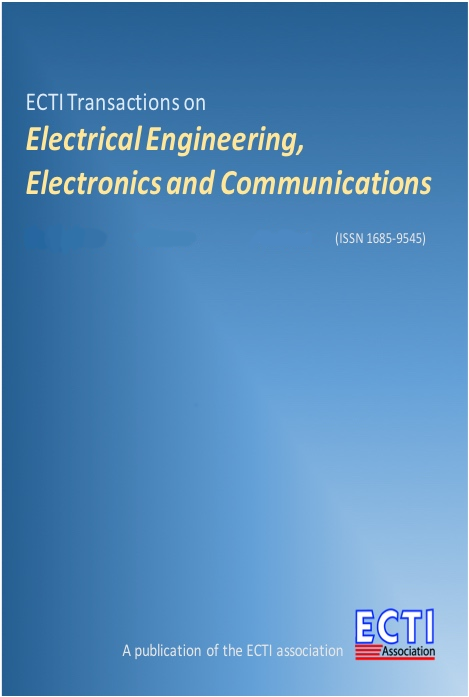Study of RSS-Based Indoor Positioning System for Target Using Visible Light Communication
Main Article Content
Abstract
An optical wireless positioning system that uses white light-emitting diodes (LEDs) based on Visible Light Communication (VLC) is presented in this paper. In the proposed system, four LEDs are employed for illumination and communication. The trilateration technique is used for determining the receiver's location and the practical Received Signal Strength (RSS) measurements are used for distance estimation. The impact of ambient light on Signal-to-Noise-Ratio (SNR) is studied by taking into consideration the first-order light reflection off of the ceiling, floor, and walls for channel modeling with both direct and indirect sunlight exposure. A modeling equation from the RSS measurements is proposed. The results show that the illuminance in all of the places in the room can be satisfied. Furthermore, the average positioning error by adopting the derived equation and trilateration technique was an error of less than 3 cm.
Article Details
This journal provides immediate open access to its content on the principle that making research freely available to the public supports a greater global exchange of knowledge.
- Creative Commons Copyright License
The journal allows readers to download and share all published articles as long as they properly cite such articles; however, they cannot change them or use them commercially. This is classified as CC BY-NC-ND for the creative commons license.
- Retention of Copyright and Publishing Rights
The journal allows the authors of the published articles to hold copyrights and publishing rights without restrictions.
References
[2] S.H. Yang, D.R Kim, H.S. Kim, Y.H. Son, and S.K. Han, “Indoor positioning system based on visible light using location code,” In Proceedings of Communications and Electronics (ICCE), pp. 360–363, 2012.
[3] A.L. Pak, A. Rastegarnia, A. Khalil and Md. K. Islam, “A Distributed Target Localization Algorithm for Mobile Adaptive Networks,” ECTI Transactions on Electrical Engineering, Electronics, and Communications, , Vol.14, No.02, pp. 47–56, August 2016.
[4] Z. Zhou, M. Kavehrad, and P. Deng, “Indoor positioning algorithm using light-emitting diode visible light communications,” Optical Engineering. 51(8) 085009, 2012.
[5] N. UL-Hassan, A. Naeem, M. Adeel Pasha, T. Jadoon and CH. Yuen, “ Indoor Positioning Using Visible LED Lights:A Survey,” ACM Computing Surveys, Vol. V, No. N, Article A, pp 01-30, 2015.
[6] G Liane, A Paraskevopoulos, J. Hilt, et al, “High-speed visible light communication systems,” IEEE Communication Magazine, 51, pp 60–66, 2013.
[7] X. Huang, Y. Wang, Y. Wang, et al, “Experimental demonstration for high speed integrated visible light communication and multimode fiber communication system,” IET Optoelectronic, 9, pp 207–210, 2015.
[8] W Zhang, M. I. S Chowdhury and M Kavehrad, “ Asynchronous indoor positioning system based on visible light communications,” Optical Engineering, vol. 53( 4) 045105, 2014.
[9] L. Wang, CH. Wang, X. Chi, L. Zhao and X. Dong, “ Optimizing SNR for indoor visible light communication via selecting communicating LEDs,” Optics communications, Elsevier, 387, pp. 174-181, 2017.
[10] D. O’Brien et al, “Indoor Visible Light Communications: challenges and prospects,” Proceeding of SPIE Vol. 7091 709106, 2008. [Doi:10.1117/12.799503].
[11] A. Chaabna, A. Babouri, and X. Zhang, “An Indoor Positioning System Based on Visible Light Communication Using a Solar Cell as Receiver,” Artificial Intelligence in Renewable Energetic Systems: Smart Sustainable Energy Systems, Springer, pp. 43-49, 2018.
[12] V. Jungnickel, V. Pohl, S. Nonning and C. Von Helmolt, “A Physical Model of the Wireless Infrared Communication Channel,” IEEE Journal on Selected Areas in Communications, Vol. 20 No.3, pp. 631-640, 2002.
[13] M. Karppinen, K. Kataja, J.T. Makinen, S. Juuso, H.J. Rajaniemi,P. Paakkonen, J. Turunen, J.T. Rantala, and P. Karioja, “Wireless infrared data links: ray-trace simulations of diffuse channels and demonstration of diffractive element for multibeam transmitters,”Optical Engineering, 41(4) , pp. 899-910,2002.
[14] J. Panta, P. Saengudomlert and K. Sripimanwat, “Performance Improvement of ACO-OFDM Indoor Optical Wireless Transmissions Using Partial Pre-Equalization,” ECTI Transactions on Electrical Engineering, Electronics, and Communications, Vol.14, No.1, pp. 1–11, February 2015.
[15] J. M. Kahn and J. R. Barry, “Wireless infrared communications,” Proceedings IEEE, 85(2), pp.265–298, 1997.
[16] A. Sivabalan and J. John, “Improved power distribution in diffuse Indoor Optical Wireless systems employing multiple transmitter configurations,” Optical and Quantum Electronics, 38, pp.711-725, 2006.
[17] T. Komine and M. Nakagawa,“Fundamental analysis for visible-light communication system using LED lights,” IEEE Transactions on Consumer Electronics,50(1), pp.100–107, 2004.
[18] A. J. Moreira, R. T. Valadas, and A. M. de Oliveira Duarte, “Optical interference produced by artificial light,” Wireless Networks, 3(2), pp.131–140, 1997.
[19] R. G. Smith and S. D. Personick, “Receiver design for optical fiber communication systems,” In Semiconductor Devices for Optical Communication, Springer, pp. 89–160, 1982.
[20] G. Archenhold, "Health and safety of artificial lighting,” Mondo Arc 63 , pp. 111–118, 2011.
[21] Z. Guo1, Z. Jia, W. Xia, Y. Zhang and L. Shen, “Indoor Localization System for Mobile Target Tracking based on Visible Light Communication,” IEEE, pp. 1–5, 2017.


